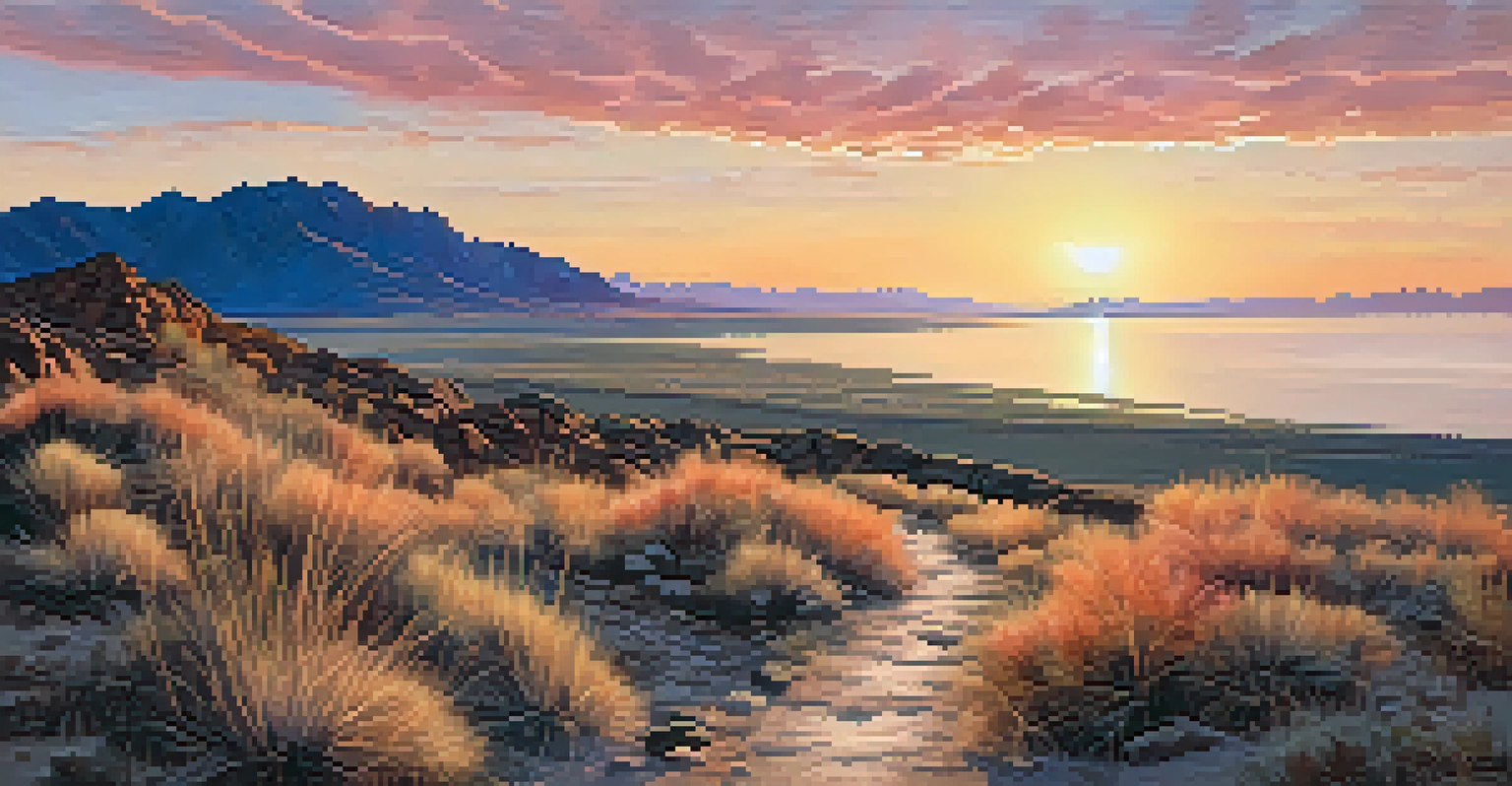Exploring Utah's Majestic Mountains: A Geographic Overview

An Introduction to Utah's Diverse Mountain Ranges
Utah is home to a stunning array of mountain ranges, each with its own unique character. From the towering Wasatch Range to the rugged Uinta Mountains, these peaks provide breathtaking views and diverse ecosystems. With elevations reaching over 13,000 feet, these mountains are not just a sight to behold but also a haven for outdoor enthusiasts.
The mountains are calling and I must go.
The Wasatch Range, stretching along the eastern edge of the Salt Lake Valley, is particularly popular for skiing, hiking, and mountain biking. In contrast, the Uinta Mountains, known for their unique east-west orientation, offer a completely different experience with their alpine lakes and extensive trail systems. This geographical diversity makes Utah a prime destination for adventurers.
As we delve deeper into each range, we’ll explore what makes these mountains so special and how their geography influences the surrounding environment. Whether you’re a casual hiker or an experienced mountaineer, Utah’s mountains promise a journey of discovery.
The Wasatch Range: A Closer Look
The Wasatch Range is often the first mountain range that comes to mind when thinking of Utah. This impressive range features over 100 peaks, many of which exceed 11,000 feet. Not only is it a playground for winter sports enthusiasts, but it also provides stunning vistas and recreational opportunities year-round.

Home to several national parks and ski resorts, the Wasatch Range attracts visitors from all over the world. Places like Park City and Snowbird are renowned for their exceptional slopes, while the numerous hiking trails—like the famous Mount Timpanogos hike—offer breathtaking views and a chance to connect with nature.
Utah's Mountains Offer Diverse Adventures
From skiing in the Wasatch Range to fishing in the Uinta Mountains, Utah's mountain ranges provide a variety of recreational opportunities for all skill levels.
The geography of the Wasatch also impacts the local climate, contributing to its snowy winters and lush summers. This diverse weather pattern supports a variety of flora and fauna, making it an ecological treasure trove that continues to fascinate nature lovers.
The Uinta Mountains: Unique and Untamed
The Uinta Mountains stand out not only for their east-west orientation but also for their rugged terrain and pristine wilderness. This range is notable for containing the highest peak in Utah, Kings Peak, which rises to over 13,500 feet. Its unique geography offers a different type of experience compared to the Wasatch, with more remote trails and fewer crowds.
In every walk with nature one receives far more than he seeks.
Adventurers will find a wealth of opportunities in the Uintas, from fishing in its numerous alpine lakes to backpacking through its expansive wilderness. The range is also home to the Uinta-Wasatch-Cache National Forest, providing ample camping options and a chance to immerse oneself in the tranquil beauty of nature.
The Uinta Mountains are a reminder of the untamed beauty of the American West. With their stunning landscapes and diverse ecosystems, they provide a perfect escape for those seeking solitude and adventure.
The Bonneville Shoreline: A Geological Marvel
The Bonneville Shoreline is a fascinating geological feature that tells the story of Utah's ancient Lake Bonneville. This massive lake once covered much of western Utah and left behind a distinctive shoreline that can still be seen today. Following this shoreline provides a unique perspective on the region’s geological history and the forces that shaped its mountains.
Hiking along the Bonneville Shoreline Trail offers stunning views of the Great Salt Lake and the surrounding valleys. It's a popular spot for both locals and tourists who want to experience the beauty of Utah's landscape while learning about its geological past. The trail serves as a reminder of the lake's vastness and its impact on the region's ecology.
Rich Wildlife and Ecosystems Abound
The diverse habitats in Utah's mountains support a wide array of wildlife, highlighting the importance of conservation efforts to maintain ecological balance.
Exploring the Bonneville Shoreline not only enriches our understanding of Utah’s topography but also connects us to the ancient history of the land. It's a humbling experience to walk along a path that has been shaped by nature over thousands of years.
Wildlife in Utah's Mountain Ranges
Utah’s majestic mountains are not just a feast for the eyes; they are also home to an incredible variety of wildlife. From the elusive mountain lion to the playful marmot, these ranges support a diverse ecosystem that thrives in the different elevations and climates. Birdwatchers will delight in spotting species like the golden eagle soaring above the peaks.
The diversity of habitats within these mountain ranges allows for a rich tapestry of life. Higher elevations are often home to species specially adapted to harsh conditions, while lower elevations support different types of flora and fauna. This biodiversity is crucial for maintaining the ecological balance in the region.
Understanding the wildlife that inhabits these mountains enhances our appreciation for them. Observing animals in their natural habitat provides insight into the delicate relationships that exist within these ecosystems, reminding us of the importance of conservation efforts.
Recreational Opportunities Abound
Utah's mountains offer endless recreational opportunities for everyone, from casual walkers to hardcore adventurers. The numerous hiking and biking trails cater to all skill levels, ensuring that everyone can experience the beauty of the outdoors. In winter, the same trails transform into popular skiing and snowshoeing spots, providing year-round enjoyment.
For those who prefer water activities, the mountain lakes offer excellent fishing, kayaking, and paddleboarding opportunities. The stunning scenery provides a picturesque backdrop for any outdoor activity, making it easy to connect with nature and unwind from the hustle and bustle of everyday life.
Conservation is Key for Future Generations
As outdoor activities increase, effective conservation measures are essential to preserve Utah's natural landscapes for future visitors.
Engaging in these outdoor activities not only provides physical benefits but also fosters a sense of community among adventurers. Whether you’re sharing a trail with friends or meeting fellow nature lovers at a scenic overlook, the mountains serve as a gathering place for those who share a passion for the great outdoors.
Conservation Efforts in Utah's Mountains
As the popularity of outdoor activities in Utah's mountains grows, so does the need for effective conservation efforts. Protecting these natural landscapes is crucial for maintaining their beauty and ecological integrity. Local organizations and government agencies work tirelessly to implement sustainable practices that safeguard these precious resources.
Many initiatives focus on educating the public about responsible recreation and the impact of human activities on the environment. By promoting Leave No Trace principles, these organizations encourage visitors to minimize their footprint and preserve the pristine nature of the mountains for future generations.

Conservation isn't just about protecting the land; it's also about fostering a connection between people and nature. By engaging in conservation efforts, we become stewards of the mountains, ensuring that their majestic beauty continues to inspire and provide for all who visit.